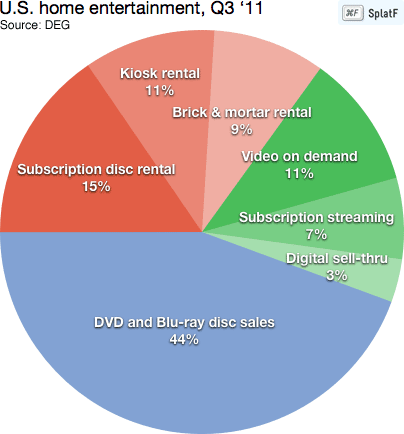Reality check: DVD and Blu-ray are still clobbering iTunes and Netflix
 While we breathlessly debate Apple’s potential to reshape the TV landscape or Netflix’s communication gaffes, it’s a little jarring to be reminded that digital is still barely one-fifth of the U.S. home entertainment market, while physical media still represents the vast majority of spending.
While we breathlessly debate Apple’s potential to reshape the TV landscape or Netflix’s communication gaffes, it’s a little jarring to be reminded that digital is still barely one-fifth of the U.S. home entertainment market, while physical media still represents the vast majority of spending.
In other words: We’re just getting started with this whole digital living room thing.
Specifically, DVD and Blu-ray sell-thru and rentals still represented about 79% of the $3.9 billion that U.S. consumers spent on home entertainment in Q3, according to DEG, an industry association.
(Blu-ray, despite its questionable start, actually seems to be doing okay. Some 33.5 million homes in the U.S. had Blu-ray at the end of Q3, up 52% year-over-year, according to DEG. That’s about half of the 69.5 million U.S. households with HDTVs. And Blu-ray disc sales were up 58% year-over-year in Q3.)
Digital represented about 21% of spending, led by video-on-demand. Note that this represents consumer spending, and not overall industry revenue, so ad revenue from sites like Hulu isn’t included.
A few takeaways:
- There’s still incredible room for growth for digital entertainment providers, such as Netflix, Apple, Amazon, Microsoft, the cable companies, etc.
- The idea of “owning” digital movies seems to be much less important to people than owning physical movies. (Seems logical, no?) Disc sales revenue is much higher than disc rental revenue. But digital rental revenue is much higher than digital sales revenue. This could be skewed by any number of issues — inconsistent availability of content in different sales models, etc. — but I think it’s the right idea.
- The industry’s 5% growth in Q3 — its first growth period since 2008 — is good news. But the inevitable shift to digital suggests spending will shrink more ahead. Unless the industry can drive spending another way.
- We still haven’t seen if UltraViolet, the industry’s new hybrid disc/digital sales model, will be successful. I’m skeptical, but maybe it’ll work.
Also: Reality check: Two-thirds of Americans still don’t have smartphones

Check out my new site: The New Consumer, a publication about how and why people spend their time and money.

